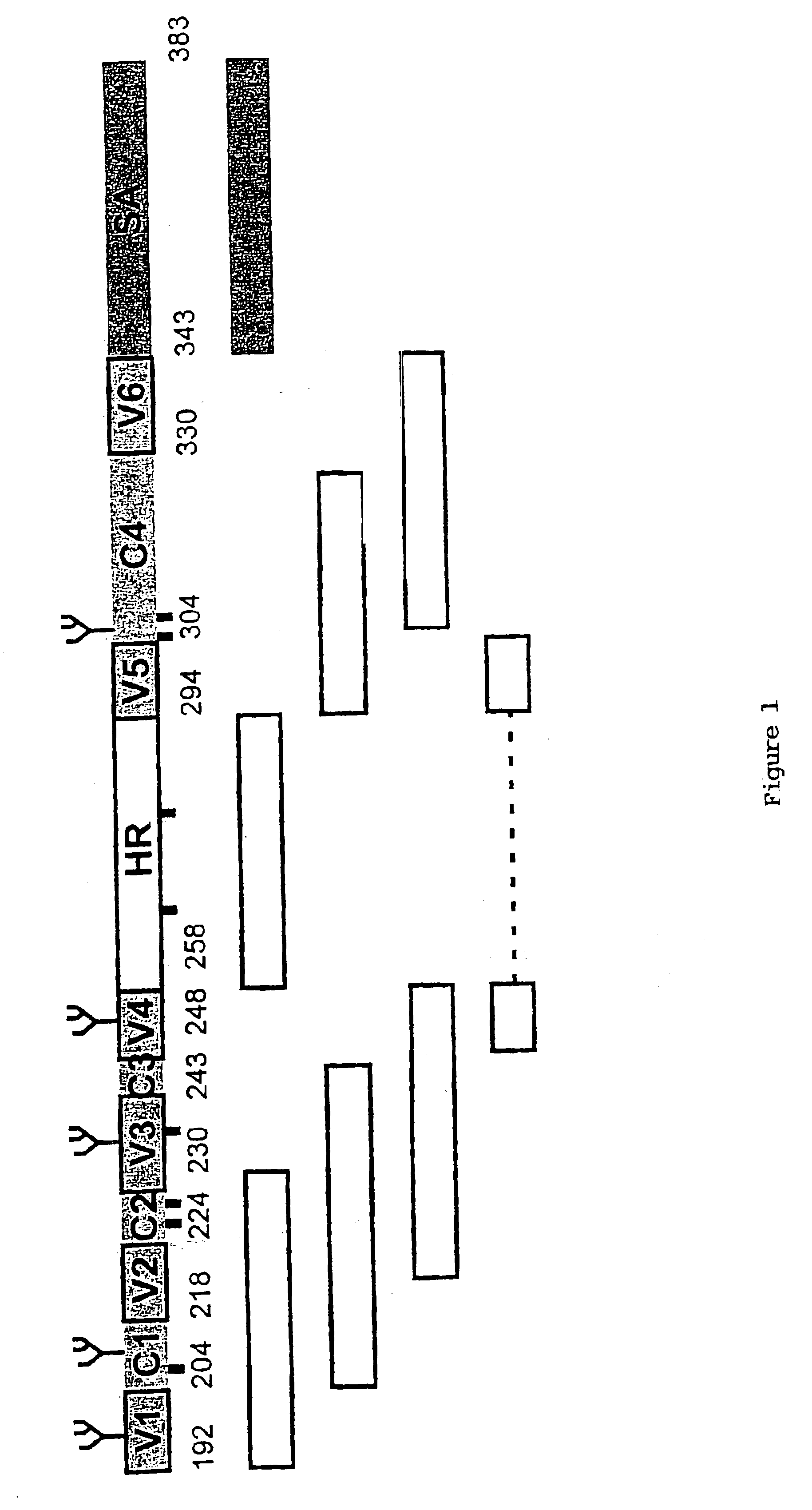Multi-mer peptides derived from hepatitis C virus envelope proteins for diagnostic use and vaccination purposes
a technology of hepatitis c virus and envelope proteins, which is applied in the direction of viruses, drug compositions, biological material analysis, etc., can solve the problems of inability to recognize anti-e1 and anti-2 ab's in sera from hcv patients, and the infection of hcv is a major health problem, so as to achieve efficient recognition of the majority
- Summary
- Abstract
- Description
- Claims
- Application Information
AI Technical Summary
Benefits of technology
Problems solved by technology
Method used
Image
Examples
example 1
[0089]Synthesis of Multimer E1 and E2 Peptides
[0090]We aimed at synthesizing peptides which would display epitopes, similar to the ones present on E1 and E2 peptides expressed in mammalian cells. Since such epitopes do not seem to be present in E1 and E2 proteins expressed in E. coli, the design of such peptides was not an easy task. We first aligned E1 and E2 primary amino acid sequences of different HCV genotypes and delineated variable and constant domains. It was reasoned that these domains, or a combination of two or more of these domains might represent conformational domains, ie form or constitute independent conformational units. If displayed as 3D structure, these conformational domains may also contain conformational epitopes. The latter domains may therefore be able to adopt a native-like structure as is present in the envelope proteins when these envelope proteins are expressed in mammalian cells. In contrast, such structures are absent when the envelope proteins are exp...
example 2
[0093]Reactivity of Multimer Peptides with E1 and E2 Antibodies in Patient Sera
[0094]A series of 60 randomly chosen samples from patients with chronic active hepatitis C were tested for reactivity with the multimer peptides. These samples did not show any notable reactivity with 20-mer peptides except for some 20-mer peptides derived from the HVRI. For comparison, reactivity with the hydrophylic ectodomain of E2, the recombinant E2h protein, was assayed (E2h extends from aa 384-708 and was cloned from SEQ ID NO 45, and expressed and purified as described in PCT / EP 95 / 03031). Peptides were coated onto streptavidin-coated plates (5 μg / ml) and antibodies in serum samples were left to react and detected using the reagents and procedures as described in the package insert of the INNOTEST HCV Ab III kit (Innogenetics, Gent, Belgium). Table 2 shows the results of the ELISA tests, in which a cutoff of 150 mOD was used. In this series, 5 sera did not show reactivity with the E2h protein, onl...
example 3
[0097]Monitoring of E1 and E2 Antibodies in Patients with Response to Interferon-alpha Therapy
[0098]In Table 5, results of E2 antibody tests as described in example 2 are given for consecutive samples obtained from patients with response to interferon therapy. A decline in E2Ab, and to a larger extend E1Ab, has been described in PCT / EP 95 / 03031 in case of a long-term response to interferon treatment. Reactivities to several peptides of the present invention also show similar declining levels. Peculiar reactivities could sometimes be detected as exemplified in patient 2: upon the detection of reappearing virus, antibody responses to the (E1)V4V5 region and the (E2)HVRII region could be detected; these quickly disappeared simultaneously with viral clearance. (E1)V4V5 and (E2)HVRII may therefore be particularly useful peptides for disease monitoring, especially in treatment of disease. Other peptides such as (E2)C1 (example 2) and those shown in bold in Table 5 also seem to be useful f...
PUM
| Property | Measurement | Unit |
|---|---|---|
| conformational structures | aaaaa | aaaaa |
| reactivity | aaaaa | aaaaa |
| reactivities | aaaaa | aaaaa |
Abstract
Description
Claims
Application Information
 Login to View More
Login to View More - R&D
- Intellectual Property
- Life Sciences
- Materials
- Tech Scout
- Unparalleled Data Quality
- Higher Quality Content
- 60% Fewer Hallucinations
Browse by: Latest US Patents, China's latest patents, Technical Efficacy Thesaurus, Application Domain, Technology Topic, Popular Technical Reports.
© 2025 PatSnap. All rights reserved.Legal|Privacy policy|Modern Slavery Act Transparency Statement|Sitemap|About US| Contact US: help@patsnap.com



